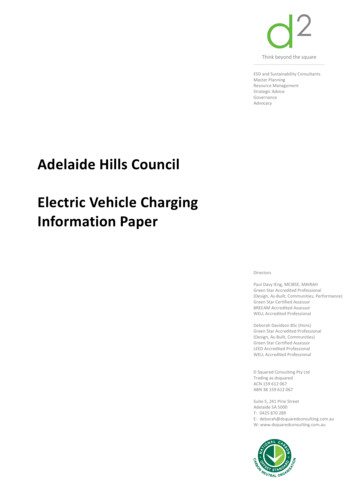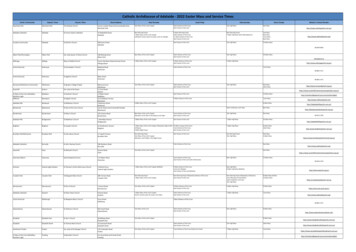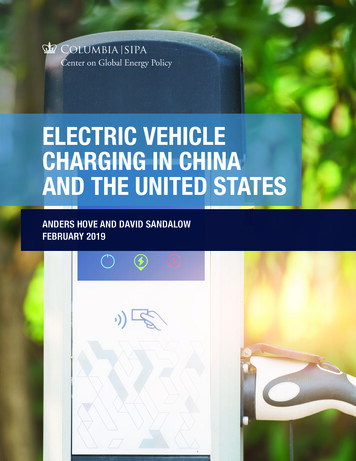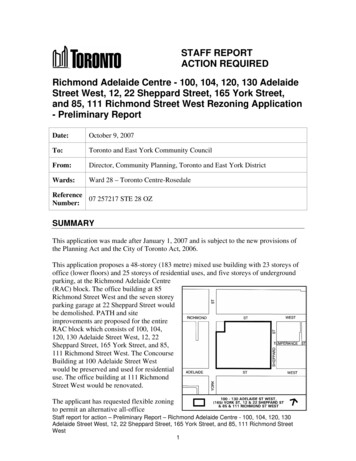
Transcription
ESD and Sustainability ConsultantsMaster PlanningResource ManagementStrategic AdviceGovernanceAdvocacyAdelaide Hills CouncilElectric Vehicle ChargingInformation PaperDirectorsPaul Davy IEng, MCIBSE, MAIRAHGreen Star Accredited Professional(Design, As-Built, Communities, Performance)Green Star Certified AssessorBREEAM Accredited AssessorWELL Accredited ProfessionalDeborah Davidson BSc (Hons)Green Star Accredited Professional(Design, As-Built, Communities)Green Star Certified AssessorLEED Accredited ProfessionalWELL Accredited ProfessionalD Squared Consulting Pty LtdTrading as dsquaredACN 159 612 067ABN 38 159 612 067Suite 5, 241 Pirie StreetAdelaide SA 5000T: 0425 870 289E: deborah@dsquaredconsulting.com.auW: www.dsquaredconsulting.com.au
Executive SummaryThis information paper provides an overview of electric vehicles (EV’s) in Australia, including currentcharging infrastructure in the Adelaide Hills Council (AHC) boundary, recommendations for futurecharging stations and opportunities for integrating additional EV’s into the Council’s fleet.This information has been used to inform AHC’s Carbon Management Plan, to provide recommendationsfor the integration of EV infrastructure and fleet.The following key recommendations are proposed: Install EV charging stations at key strategic locations for Council and public useoCapital funding is recommended for Council EV fleet charging stationsoA fee for use model should be adopted to provide a cost recovery model to maintain andoperate the stationsoGrant programs or commercial agreements are alternative models to implement EVcharging stationsoDevelop detailed specifications to ensure charging stations cater for all EV makes andmodelsImplement a vehicle procurement policy to transition the Council’s vehicle fleet to EVsoStaged process to gradually transition to EVsoInclude process for all future medium and heavy vehicle purchases to include an EVcomparison and cost benefit analysisWork with East Waste to investigate electric waste trucks2028 AHC EV Information Paper
Document rst issueJPDD208/05/2019Second issue – Reordered andadditional information addedJPDD317/05/2019Third issue – Minor update basedon feedbackJPDD426/06/2019Minor updateJPDD54/09/2019Final updateJPDDIt should be recognised that the electric vehicle industry in Australia is relatively young and rapidly evolving, withcompeting industry advocacy bodies promoting alternative technologies which are not always directly compatible.For this reason, it is important that this guidance is accepted as current at the time of writing only, and that theproposed systems to be deployed is regularly reviewed for currency.2028 AHC EV Information Paper
ContentsExecutive Summary . ii1Introduction . 52Electric Vehicles in Australia. 62.1Private Electric Vehicles . 62.2Medium and Heavy Vehicles . 72.3Electric Bikes and Scooters . 83Electric Vehicles . 93.1Makes and Models . 93.2Adelaide Hills Council EV Fleet . 94Charging Stations and Plug Types . 104.1Charging Stations Charge Rate . 104.2EV Charging Capacity . 104.3EV Charging Plugs . 115Existing infrastructure . 126Recommended charging station solutions . 136.17Bike charging stations. 13Potential new charging locations . 147.1Charging station costs . 167.2Charging station funding models . 167.3Time limits . 17Appendix A: Electric Charging Plugs (Detailed) . 18Appendix B: Charging Stations (Detailed) . 20Appendix C: Charging Stations Examples . 212028 AHC EV Information Paper
1IntroductionThis information paper provides an overview of electric vehicles (EV’s) in Australia, including currentcharging infrastructure in the Adelaide Hills Council (AHC) boundary, recommendations for futurecharging stations and opportunities for integrating additional EV’s into the Council’s fleet.This information has been used to inform AHC’s Carbon Management Plan, to provide recommendationsfor the integration of EV infrastructure and fleet.Page 52028 AHC EV Information Paper
22.1Electric Vehicles in AustraliaPrivate Electric VehiclesElectric vehicles have been commercially available in Australia since 2010 with an exponential growthoccurring in vehicle registrations since 2014. Latest estimates are that over 2,700 EV’s were sold in 2018and this is based on EV registrations and unofficial Tesla sales figures (Tesla do not release sale figures).The following figure shows the growth of EV sales in recent years.Figure 1: Electric Vehicle Registrations 2010-2017. Source: Climate Works AustraliaConsistent with Australian vehicle sales generally, the most popular electric vehicles are manufacturedpredominantly by Japanese firms (comprising 80% of total registrations in 2016). Tesla have captured thepremium vehicle market (comprising 9% of 2016 registrations), supported in part by their investment in“Supercharger” stations which provide electricity to Tesla owners for free, with the Australian arm of GM,Holden, making inroads in the economy market with a 7% market share. This will continue to change asnew EV manufacturers and lower cost options enter the Australian market and as Holden has ceasedselling the Volt in Australia. In particular Hyundai, Kia and Tesla are all expected to release EV’s 60,000for sale in 2019 which will impact the market share distribution.Latest projections from the Australian Energy Market Operator (AEMO) are that with moderateintervention from across government, EV sales will increase from approximately 2,700 vehicles in 2018,to 70,000 by 2023 and will make up the majority of vehicle sales by 20501. Moderate intervention includestargets being set by state governments as part of net-zero strategies, transitioning state and localgovernment fleets to EV’s and the rollout of charging infrastructure.Figure 2 illustrates the increased uptake of EV sales in various scenario’s of Government intervention.1“Australian Electric Vehicle Market Study”, Australian Energy Market Operator, p. 6-7Page 62028 AHC EV Information Paper
Figure 2: The State of Electric Vehicles in Australia”, Climate Works Australia, June 2018, p. 4The uptake of electric vehicles in South Australia is currently one of the highest per capita in Australia whichmay be due to the availability of public charging stations (second highest per capita2) and the knowledge thata large percentage of our electricity comes from renewable sources i.e. fossil fuel electricity generation is oftencited as a reason not to support EV’s due to the emissions associated with coal and gas fired power stations.EV’s have been further supported by programs such as the City of Adelaide Council’s Electric Vehicle ChargingHub and on-street stations in the Adelaide CBD where there are now 46 charging stations available. Since thesestations were implemented there have been over 4,000 vehicle charging sessions and over 12MWh ofelectricity delivered to EV’s3.Although there are no specific studies into distances travelled between charges for electric vehicles and wherethey are charged (home versus public charging), the average daily commute for South Australian’s is 13.76km4or 137.6km per week which is well within the range of a single charge for most EV’s. It is expected that themajority of EV owners charge their vehicle at home overnight using either a standard wall plug or with a homecharging station, unless convenient charging stations are provided at their place of employment or parkingcomplex.The provision of public charging infrastructure by government (Federal/State/Local) is one of the top threeareas that consumers believe will increase the uptake of electric vehicles, along with subsidies for EV’s andinstalling home charging systems5. With current projections this provides an argument to increase investmentin EV charging stations by the Council to support EV owners in visiting the Adelaide Hills region.2.2Medium and Heavy VehiclesIn line with passenger EV’s, current uptake of medium and heavy electric vehicles (trucks and buses) isrelatively low, however is expected to grow significantly in the coming years. Electric truck and bus salesare expected to grow between 9% to 17% per annum through to 20306 across OECD countries.Some of the key challenges for medium and heavy EV’s is the need for significant charging infrastructurerequired to charge the vehicles efficiently and distances travelled for regional routes exceeding currentlyavailable EV ranges without charging infrastructure being available. Companies such as Volvo,Volkswagen, Izuzu (Mitsubishi), Iveco and Tesla are all developing heavy EV’s. Trials are also underway,2“The State of Electric Vehicles in Australia”, Climate Works Australia, June 2018, p. 13Adelaide City Council, ailable-in-adelaide, accessed 09/04/194Australian Bureau of Statistics - Census of Population and Housing: Commuting to Work5“The State of Electric Vehicles in Australia”, Climate Works Australia, June 2018, p. 46Navigant Research - Market Data: Electric Trucks and Buses3Page 72028 AHC EV Information Paper
with Woolworths trialling electric distribution trucks and Councils in WA and VIC trialling electric wastetrucks, which have relatively fixed routes with known travel distances. It is recommended the Councilengage with East Waste to investigate options to transition to an EV waste fleet, which will reduceemissions and pollution associated with waste trucks.As the Council operates a community bus and it is expected that the distance travelled will be fairlyconsistent, it is recommended the Council investigate transitioning to an electric bus when the currentvehicle is due for replacement.2.3Electric Bikes and ScootersAustralia has adopted the European standard (EN15194) for electric bikes and scooters (e-bikes) whichlimits the speed to 25km/h and motor power to 250W for pedal assisted bikes, however this standard wasnot adopted across all states until 2015. As a result, e-bike uptake has been relatively slow compared tointernational markets (in particular Europe and China). E-bike sales are expected to increase as batteryprices continue to decrease and as more models become available. Depending on the battery size, motorpower and the type of use, e-bikes typically have a range of 50-200km. Prices range from approximately 1,200 for entry level to 10,000 for premium off-road models.Due to the range of different battery sizes and types found in e-bikes, each bike will have a compatiblecharger which plugs into a standard mains supply power point (240V). Current e-bikes for sale in Australiahave a charge time of 4-10 hours for a full charge or 2 hours for a meaningful extension of range. As aresult, it is expected that providing public charging infrastructure will have minimal impact on uptake asthe user is required to carry their charger with them and leave their bike and portable charger in a publicarea for extended periods. Most e-bikes allow the user to remove the battery and therefore charge inmore convenient locations (e.g. inside the library or local café).Newer e-bikes are starting to enter the market with faster charging capabilities (2-4 hours for a full charge)and this may increase the need for providing public charging stations, however these bikes will also haveincreased range. For example, newer higher capacity batteries have a range of 150-200km which willallow a user to travel from Stirling to Mount Pleasant and return on the same charge including taking intoaccount the topography.Page 82028 AHC EV Information Paper
33.1Electric VehiclesMakes and ModelsThe following provides a breakdown of the current Australian plugin EV fleet. The Mitsubishi Outlanderand Holden Volt (65% of the fleet) are both hybrid plug-in EV’s with a petrol and electric engine to provideassurance that the vehicle will not run out of charge without a nearby charging station.Vehicle% of the current Australian fleetMitsubishi Outlander58%Nissan Leaf15%Tesla Model S9%Holden Volt7%Balance of fleet11%As EV’s and battery technologies have continued to improve, range anxiety are less of a concern with newmodels providing between 200-600km per charge. The following EV’s are entering the market in 2019.VehicleRangeTesla Model 3350-520kmNissan Leaf (second gen) 240kmKia e-Niro500kmHyundai Kona400km3.2Adelaide Hills Council EV FleetThe AHC EV fleet currently consists of Toyota Hybrid Corollas, which charge while driving (not plug-in),and Mitsubishi PHEV hybrid plugin vehicles. Although plug-in hybrid options provide a good balancebetween emissions, performance and reducing range anxiety, it is recommended the Council transitionto full electric vehicles as part of a planned phase out of internal combustion engine (ICE) vehicles toreduce vehicle emissions. This is further supported by reducing costs and improved performance/rangefor EV’s.Moreland City Council have implemented a mandatory procurement policy for all light vehicles whichhighly preferences EV’s over hybrids and ICE vehicles unless there is a specific need that an EV is unableto achieve (e.g. long-distance regional travel). It is recommended the Council implement a similar processto gradually phase out ICE and hybrid vehicles over time, including a cost benefit analysis comparing wholeof life costs.Page 92028 AHC EV Information Paper
4Charging Stations and Plug TypesCharging Stations provide the connection point between the electricity supply network and the vehiclecharging system. Charging stations can be either wall or floor mounted and the selection of a station willneed to be made cognisant of the car park design, access, and other physical constraints. Depending onthe charging station type (AC vs. DC) and number of plugs catered for, charging stations can be relativelyunobtrusive and should have a minimal impact on car park designs (see Appendix C for examples).Charging stations also provide customer billing, customer service, and energy management services ifconnected to an integrated management system. These are highly recommended. It is also recommendedthat SA Power Networks (SAPN) are engaged early to plan the installation of EV charging stations as SAPNwill need to understand the potential impact on the electricity network, and also use EV charging stationsto monitor the status of the grid below transformer level.4.1Charging Stations Charge RateThe Society of Automotive Engineers (SAE) International have established a charging level protocol inorder to define the speed and therefore quality of charging that a station can provide (refer Appendix Bfor detailed information). The protocol has 6 levels with 3 AC standard charging rates and 3 DC fastcharging rates.The main public EV charging stations available in Australia are AC “Level 2” 7.4kW and “Level 3” 22kWchargers which provide a higher charge rate than home installations and DC charging stations such asTesla Superchargers (DC “Level 3”).4.2EV Charging CapacityTo ensure the vehicle charging stations match the available EV fleet in Australia, it is important tounderstand the maximum charge capacity and plug types of available EV’s, which is as follows:VehicleBattery Charge Capacity1Charging plug type (AC / DC)Mitsubishi Outlander3.7kWJ-1772 / CHAdeMONissan Leaf3.3kW to 6.6kWJ-1772 / CHAdeMOTesla Model S11kW to 22kWTesla combo charge plugHolden Volt6.6kWJ-1772 / CHAdeMOBalance of fleet3.3kW to 7.4kW (1)Various1 This is the charge rate of the battery (its capacity to charge) not the total energy required to charge the battery.The vehicle charge capacity for new 60,000 electric vehicles entering the market in 2019 is as follows:VehicleBattery Charge Capacity1Charging Plug Type (AC / DC)Tesla Model 311kWType 2 / CCSNissan Leaf (second gen)6.6kWJ-1772 / CHAdeMOKia e-Niro7.2kWType 2 / CCSHyundai Kona7.2kWType 2 / CCSAs per the above, the majority of EV’s in Australia are not capable of AC charging rates higher than 7.4kWand therefore charging stations with AC Level 2 (7.4kW) charge stations are recommended.Page 102028 AHC EV Information Paper
4.3EV Charging PlugsFollowing identification of the charging station charge rate, it is important that the charging station plugtypes are also compatible with the majority of EV’s and consider future trends. The electric vehicleindustry has yet to agree on a global common standard for charging plug types.The J-1772 (AC) and CHAdeMO (DC) plugs are the most prominent charging plugs currently in use inAustralia, and were the preferred plug type of more than 80% of the Australian vehicle market place(Japanese car manufacturers). The remaining 20% and newer EV’s (Tesla Model 3, Kia and Hyundai) useEuropean charging plug architecture with the Type 2 “Mennekes” (AC) and SAE CCS (DC) plugs or TeslaCombo Plugs for older models.It is therefore recommended that dual AC J-1772 / Type 2 Mennekes and dual DC CHAdeMO / CCS optionsare provided in all new charging stations for the near future to cater for both existing and new EV’s.Appendix A provides detailed information on plug types.Page 112028 AHC EV Information Paper
5Existing infrastructureThe Council boundary covers a significant area and there are currently 6 publicly listed charging stationsavailable within the boundary and the Council maintains 2 of the stations for their hybrid EV fleet. Thisinformation has been derived from PlugShare, an online crowdsourced platform, and Tesla’s online maps.Torrens ValleyCommunityCentre &Applewoodi illBirdwoodNational MotorMuseumNorton SummitCommunityCentreOrganic Marketand CafeCharging Station LocationTypeCharge SocketsCharge rateAdelaide Hills Business CentrePrivate1 x J-1772Level 2 – 7.4kW1National Motor MuseumPrivate2 x Tesla (AC)Wall/Mains SocketLevel 2 – Up to 22kWTorrens Valley Community CentreAHC1 x J-1772Level 2 – 7.4kWApplewood Distillery (Gumeracha)Private2 x Tesla (AC)Level 2 – Up to 11kWNorton Summit Community CentreAHC1 x J-1772Level 2 – 7.4kWPrivate1 x Tesla (AC)2 x J-1772Level 2 – Up to 22kWOrganic Market and Café1Adelaide HillsBusiness CentreInformation not publicly available – charge rate assumedPage 122028 AHC EV Information Paper
6Recommended charging station solutionsThe most suitable charging stations to support the uptake of EV’s in the Adelaide Hills region include: 6.1Level 2 (7.4kW) AC Charging:o In areas with high passive supervision and appropriate public street lighting Level 2(7.4kW) charging stations with dual J-1772 and Type 2 Mennekes plug. This will cater forall EV’s and will complement existing Level 2 J-1772 and Tesla stations in the AHC region.o Locations adjacent restaurants and tourist/public facilities (e.g. Stirling Library, TheStirling Hotel or car park facilities) are recommended which will provide an incentive forEV owners to visit, charge their EV while using the facilities and then continue visitingdestinations in the Adelaide Hills.Level 2 (22.1kW) AC Charging:o 22.1kW charging stations are only recommended in key strategic locations if attractingEV’s with a higher charge rate ( 11kW) is a Council priority (e.g. Tesla).DC Fast Charging:o Providing Level 3 fast charging is recommended to increase the likelihood of EV ownersvisiting the region by providing convenient and fast charging options. However, fastcharging stations have increased power capacity requirements ( e.g. 50kW) which mayexceed the intended locations mains supply capacity if multiple stations are installed.o If capital budget is not available it is recommended that the Council investigate acommercial arrangement with a private operator. This will remove upfront capital costsand reduce risks associated with operating the infrastructure, providing adequate powersupply to the charging station and nominating appropriate technologies to reduceredundancy.o Although Tesla may be a high profile option, providing universal Level 3 DC charging isrecommended to ensure all EV makes and models are catered for.Bike charging stationsIt is not recommended that the Council provide public e-bike charging stations unless there is readilyavailable access to services and secure bike storage facilities (e.g. secure/locked bike facilities).Although current use of bikes for commuting to work is minimal for Council employees, e-bike ownershipis expected to increase significantly as prices continue to decrease and performance improves. It isrecommended that the Council consider e-bike charging infrastructure in employee bike storage facilities(existing or planned) to promote low emission and active forms of travel. For example, providingaccessible power sockets in Council employee bike storage facilities will provide options for employees toride an e-bike to work and charge during the day.Page 132028 AHC EV Information Paper
7Potential new charging locationsThe following criteria has been considered to determine potential locations for new charging stations.Whilst we have considered the location of some private EV charging stations, all proposed new EVequipment would be located on Council owned land.LocationMajor Town/TouristAttractionMain Rd /Freeway /Scenic DriveExistingEVChargingFastcharging% YesBirdwoodLobethal and/orWoodsideStirlingOffice/LibraryProposed new locationsPotential additional locationsPage 142028 AHC EV Information Paper
StirlingAs the main township in the Adelaide Hills Council region with public facilities and due to the close vicinityto the main freeway, Stirling has an opportunity to provide an incentive for EV owners to visit and rechargetheir vehicles while accessing local businesses and the Adelaide Hills region.Locations include the Stirling Office car park and other off-street car parks. To support the implementationof EV’s in the Council’s fleet, it is recommended that charging stations are installed in the Stirling Officecar park. This will be further supported in the event that additional solar PV is installed (up to 100kW) onthe library roof as per the AHC’s Corporate Carbon Management Plan.Sites near to large retail operators such as Woolworths (or Coles at Bridgewater) are not recommendedas it is expected large retailers will begin to provide free EV charging stations in the near future to attractEV owners.BirdwoodThe current charging stations provide limited options for EV owners (Tesla only or wall plug) and providingadditional public charging stations will continue to promote Birdwood’s rich vehicle history while alsosupporting drivers visiting the town on the Torrens Valley Scenic Drive. A potential location is the Foodlandand bakery car park due to the close vicinity to most town facilities. Birdwood High School and theBirdwood Institute car park may be a second option due to the school recently installing a 70kW solar PVsystem on the roof of the gymnasium. This will allow a demonstration of integrating solar PV and EVcharging.Due to not being a major town or near a major highway, DC fast charging may not be viable and it isrecommended the Council wait for fast charging networks to be implemented at scale before exploringcommercial agreements to install fast charging stations.Lobethal / WoodsideAs larger townships in the region with tourism attractions, EV owners may be incentivised to visit Lobethaland Woodside by providing charging stations.Woodside: Although Woodside has an existing charging station which supports 80% of EV’s, the locationdoes not support the Council in implementing additional EV’s in their fleet. A potential location is in theWoodside Library car park to support both Council EV’s and public use. Providing 1 charging stationdedicated to the Council during business hours and publicly available outside of hours is recommended.If this option is pursued the Council should have procedures in place to ensure their vehicles are not leftin the charging bay all day without requiring additional charge.Lobethal: Lobethal has no public charging stations and a potential location is adjacent the LobethalBierhaus and Emmalines Country Kitchen where there is existing off-street parking facilities. As the Councildo not have any operations in Lobethal, providing EV charging is purely a support measure to increaseEV’s in visiting the region.Due to not being major towns or near a major highway, DC fast charging may not be viable and it isrecommended the Council wait for fast charging networks to be implemented at scale before exploringcommercial agreements to install fast charging stations. Alternatively, this could be progressed inconsultation with local businesses and/or local petrol stations.Page 152028 AHC EV Information Paper
7.1Charging station costsThe following approximate costs are expected to install EV charging stations but this does not include anyelectrical infrastructure upgrades (if required).Proposed locationCharging station and ratePlug type2Approximate cost3AC Level 2 (7.4kW or 22kW) 1J-1772 / Type 2 5,000-15,000DC Level 1 (50kW)CHAdeMO / SAE CCS 40,000- 60,000AC Level 2 (7.4kW or 22kW) 1J-1772 / Type 2 5,000-15,000Stirling OfficeBirdwood1 Council will need to identify the target charging station rate – 7.4kW is recommended2 Dual charging stations are recommended to cater for both existing and new EV’s entering the Australian market3 Costs will vary depending on availability and capacity of electrical infrastructure, distance for trenching and cabling and thecomplexity of the monitoring and control systems.7.2Charging station funding modelsThere are a number of options for installing EV charging stations and the intended use of the station willdetermine the fee model: Capital Investment: If the main purpose is to support transitioning the Council to an EV fleet, theCouncil should investigate budget availability to install charging stations. To maximise usage it isrecommended that the stations are publicly accessible with a fee for use model outside ofbusiness hours. This will support the Council’s transition to low emission vehicles and incentiviseowners to visit the region.o Charging based on the Council’s electricity rate (with a minimum/flat charge) is notexpected to be a deterrent to EV owners due to the Council improving access to charginginfrastructure. It is recommended that if the Council elects to install EV charging stationswith a fee, the stations are not restricted to one service provider and provide credit/debitcard payment option. This can be achieved by developing specifications when requestingproposals from commercial service providers Grant Programs: If the purpose is to support EV uptake and incentivise EV owners to visit theregion, it is recommended that the Council implement a grant program to support businesses ininstalling EV charging stations. For example, City of Adelaide provide grants of up to 50% or 5,000per plug as part of their Sustainability Incentives Scheme.o In this model the private operator would set a fee for use e.g. free to increase EV’s usingtheir facility or a fee for use system. Commercial Arrangement: A third option is to enter into a commercial arrangement where acharging station network operator is engaged to install and operate the stations and the Councileither provides the land or facilitates the location. Detailed specifications should be developed toensure the charging stations suppo
occurring in vehicle registrations since 2014. Latest estimates are that over 2,700 EV's were sold in 2018 and this is based on EV registrations and unofficial Tesla sales figures (Tesla do not release sale figures). The following figure shows the growth of EV sales in recent years. Figure 1: Electric Vehicle Registrations 2010-2017.










